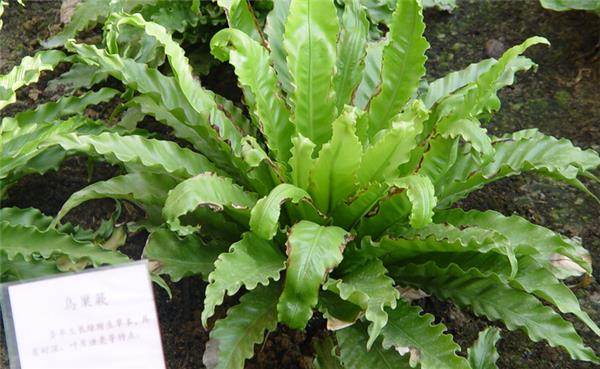The culture method and function of bird nest fern are introduced in detail.
Bird's nest ferns are commonly found in primeval forests at middle and low elevations all over Taiwan, with large size and luxuriant leaves. Bird's nest fern is different from ordinary ferns in that it has its own particularity in terms of shape and growth environment. So today let's learn more about bird's nest fern.

What are the functions of bird's nest fern?
1. Ornamental value: bird's nest fern is a large shady foliage plant with plump plant type, green and bright leaves, chic and generous, rich game, which is favored by people. Hanging indoors also has a tropical flavor; planted under tropical garden trees or rockery rocks, it can add wild interest; small potted plants are used to decorate bright living rooms, conference rooms, studies and bedrooms, which also appear small and exquisite, dignified and beautiful.
2. Medicinal value: bird's nest fern is rich in vitamin A, potassium, iron, calcium, dietary fiber and so on. The fern in the bird's nest tastes bitter and warm, entering the kidney and liver. It has the effect of strengthening muscles and bones, promoting blood circulation and removing blood stasis, and can also be used for injury, fracture, blood stasis, headache, hemolysis, impotence and gonorrhea.
3. Edible value: the edible part of bird's nest fern is its tender bud. After picking, rinse the bird's nest fern with clean water, then blanch it slightly in boiling water, remove it and drain it, add various seasonings for cold dressing, or stir-fry with other ingredients.

Can bird's nest fern absorb formaldehyde?
Bird's nest ferns can absorb formaldehyde, and ferns such as bird's nest ferns can purify the air indoors. In general, Cymbidium is a plant commonly used by citizens to absorb formaldehyde, and the effect of ferns absorbing formaldehyde is obviously better than it.
Five kinds of indoor ornamental ferns were selected to study the absorption capacity of formaldehyde. The results showed that all the five kinds of ornamental ferns had strong ability to absorb formaldehyde. Under the specific experimental environment, the ability of absorbing formaldehyde was as follows: Jinglan grass > kidney fern > bird nest fern > Dryopteris tricolor, which is of great practical significance to explore efficient and safe formaldehyde control of ornamental fern.
The culture method of bird's nest fern
1. Peat soil or rotten leaf soil is the best soil for planting potted bird nest fern. The growth depends on planting nest fern for 2-3 years, the plant shape is open, and the root is full of pot rack, which can be protruded from the basin, and some residual roots and spore leaves withered at the base can be removed, taken out in the plant and replanted in the pot respectively. When changing the basin in spring, rotten leaf soil and moss should be added to the basin, and a little gravel should be added.

two。 Temperature and light the suitable temperature for the growth of bird's nest fern is 22-27 ℃. In summer, it should be shaded or placed in a sparse place under a big tree to avoid strong direct sunlight, which is beneficial to growth and make the leaves glossy. Put it in a brightly lit place indoors, not in the dark for a long time. It should be moved into the greenhouse in winter and the temperature should be kept above 16 ℃ so that it can continue to grow, but the lowest temperature should not be lower than 5 ℃.
3. Watering and fertilization under the conditions of high temperature and humidity in summer, the vigorous growth of new leaves need more water, fully spray the leaf surface and maintain a higher air temperature, which is beneficial to spore germination. With the increase of the leaves, the leaves are often covered with the culture soil in the basin, and the pot must be watered thoroughly in order to avoid the dry and curl of the leaves caused by the lack of water.

The above introduces what are the functions of bird's nest fern and whether bird's nest fern can absorb formaldehyde. I hope it can help you to better understand bird's nest fern.
- Prev

Step-by-step analysis of the hydroponic culture method of millennium wood _ what are the functions of millennium wood
Step-by-step analysis of the hydroponic culture method of millennium wood _ what are the functions of millennium wood
- Next

Matters needing attention in potted cultivation of Anthurium andraeanum
Matters needing attention in potted cultivation of Anthurium andraeanum
Related
- Wuhan Hospital Iron Tree Blooming Result Was Instantly Frightened by the Gardener Master
- Which variety of camellia is the most fragrant and best? Which one do you like best?
- What is the small blue coat, the breeding methods and matters needing attention of the succulent plant
- Dormancy time and maintenance management of succulent plants during dormancy
- Minas succulent how to raise, Minas succulent plant pictures
- What are the varieties of winter succulent plants
- How to raise succulent plants in twelve rolls? let's take a look at some experience of breeding twelve rolls.
- Attention should be paid to water control for succulent plants during dormant period (winter and summer)
- Watering experience of twelve rolls of succulent plants
- Techniques for fertilizing succulent plants. An article will let you know how to fertilize succulent plants.

